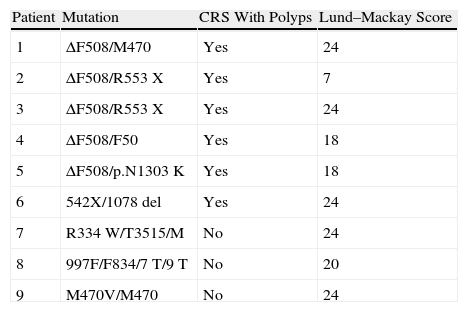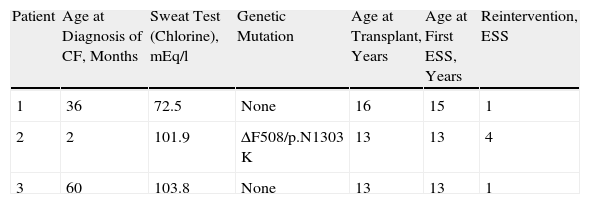Chronic rhinosinusitis (CRS) is very common in patients with cystic fibrosis (CF). This can be explained by the unified airway concept, where the same pathophysiological phenomenon that affects the lungs, affects the paranasal sinuses (PNS). The management of these cases is difficult.
ObjectiveTo describe the teamwork of otolaryngologists and bronchopulmonary specialists in patients with CF.
MethodWe performed a descriptive, retrospective study over the last 17 years, which included 14 patients with CRS and CF attended at a private hospital.
ResultsOf the patients, 64% were male and the median age was 23 years. The most frequent mutations found were ΔF508, M470 and R553. All of the patients with ΔF508 mutation had nasal polyps. 100% of the patients had clinical findings of CRS. All the patients had had endoscopic nasal surgery. The median number of endoscopic surgeries was 2.
ConclusionsGiven the high prevalence of CRS in patients with CF, everyone should have a computed tomography scan of the PNS during the initial assessment, considering that sinus germs are the ones that colonise the lower airway. The otolaryngologist should be part of the CF team. Before receiving a lung transplant or in cases of chronic headache, endoscopic surgery should be performed in patients in whom medical treatment fails to clear the sinuses because this infection is the one that colonises the lower airway.
La rinosinusitis crónica es muy frecuente en pacientes con fibrosis quística, lo que se puede explicar por el concepto de vía aérea unificada, donde el mismo fenómeno fisiopatológico que afecta a los pulmones, afecta a las cavidades paranasales. El manejo de estos casos es especialmente difícil.
ObjetivoDescribir el trabajo en equipo de otorrinolaringólogos y neumólogos en pacientes portadores de fibrosis quística.
MétodoEstudio descriptivo, retrospectivo de 14 pacientes portadores de fibrosis quística con rinosinusitis crónica atendidos durante los últimos 17 años en una clínica privada.
ResultadosEl 64% es de sexo masculino. La mediana de la edad al punto de corte del estudio es de 23 años. Las mutaciones más frecuentes encontradas son ΔF508, M470 y R553. El 100% de los pacientes con la mutación ΔF508 presentan pólipos. El 100% de los pacientes tienen clínica de rinosinusitis crónica. Todos han sido sometidos a cirugía endoscópica. La mediana del número de reintervenciones es de 2 cirugías endoscópicas.
ConclusionesDada la alta prevalencia de rinosinusitis crónica en estos pacientes, todos deberían tener una tomografía computarizada de cavidades paranasales durante su evaluación inicial considerando que son los gérmenes de las cavidades paranasales los que colonizan la vía aérea baja. El otorrinolaringólogo debe ser parte integral del equipo de fibrosis quística. La cirugía endoscópica debe realizarse en pacientes en que el tratamiento médico no logre limpiar las cavidades paranasales y sea esta infección la que esté colonizando la vía aérea inferior, antes de recibir trasplante de pulmón, o en cefalea crónica.
Artículo
Comprando el artículo el PDF del mismo podrá ser descargado
Precio 19,34 €
Comprar ahora







